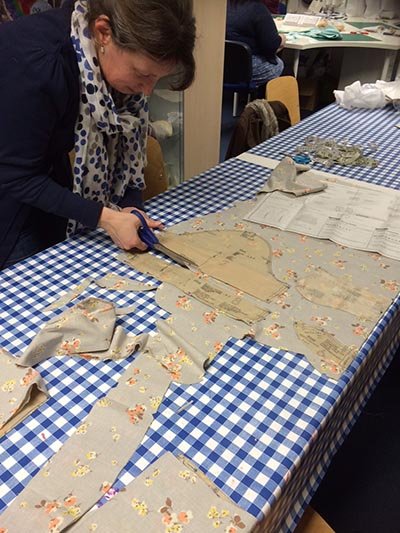One thing that students of all ages often find difficult is cutting fabric. So here is a short post on how to improve your fabric cutting abilities, because if you cut something out accurately, then it will be a LOT easier to put together accurately.

 Buy the best quality scissors you can afford. William Gee have a great range, and Fiskars are particularly highly regarded. Make sure you buy the right type of scissors for the job, so your craft kit should include a pair of dressmaking scissors, sometimes also called tailors shears, a pair of normal scissors for cutting paper and a small pair of scissors for snipping threads or delicate work called embroidery scissors.
Buy the best quality scissors you can afford. William Gee have a great range, and Fiskars are particularly highly regarded. Make sure you buy the right type of scissors for the job, so your craft kit should include a pair of dressmaking scissors, sometimes also called tailors shears, a pair of normal scissors for cutting paper and a small pair of scissors for snipping threads or delicate work called embroidery scissors.
 A scissor sharpener is also a good investment. It’s a relatively inexpensive tool that you can run your scissor blades through and it keeps them nice and sharp – sharpness is key for cutting fabric.
A scissor sharpener is also a good investment. It’s a relatively inexpensive tool that you can run your scissor blades through and it keeps them nice and sharp – sharpness is key for cutting fabric.
 Never ever use your fabric scissors for cutting paper, it will blunt them.
Never ever use your fabric scissors for cutting paper, it will blunt them.
 Fabric scissors have a long bottom blade that is designed to rest and slide along the table as you cut. Use long cuts rather than small snips so the edges of the fabric don’t become jagged. Make sure you keep the fabric as flat as possible –iron it first if you need to. Hold the scissors straight up, rather than on an angle as it will make cutting easier.
Fabric scissors have a long bottom blade that is designed to rest and slide along the table as you cut. Use long cuts rather than small snips so the edges of the fabric don’t become jagged. Make sure you keep the fabric as flat as possible –iron it first if you need to. Hold the scissors straight up, rather than on an angle as it will make cutting easier.
 If you are left-handed and you struggle with standard scissors, invest in some left-handed pairs instead.
If you are left-handed and you struggle with standard scissors, invest in some left-handed pairs instead.
 If you need to cut a symmetrical shape, fold your fabric in half and cut half a shape – that way you can get perfect hearts and butterflies. If you know you’re not very good at free hand cutting, make a paper pattern first, or search the internet – there are loads of free shapes and patterns you can download and use.
If you need to cut a symmetrical shape, fold your fabric in half and cut half a shape – that way you can get perfect hearts and butterflies. If you know you’re not very good at free hand cutting, make a paper pattern first, or search the internet – there are loads of free shapes and patterns you can download and use.
 Don’t give up! Like everything, practice makes perfect!
Don’t give up! Like everything, practice makes perfect!
Katharine runs Leicestershire Craft Centre – check it out now!






 We’re thrilled to announce that we’ve partnered with Tree Nation, the platform to reforest the world & fight climate change! Home to over 90 planting projects in 33 countries, Tree Nation is a non-profit organisation that helps people & companies offset their CO2 emissions.
We’re thrilled to announce that we’ve partnered with Tree Nation, the platform to reforest the world & fight climate change! Home to over 90 planting projects in 33 countries, Tree Nation is a non-profit organisation that helps people & companies offset their CO2 emissions.